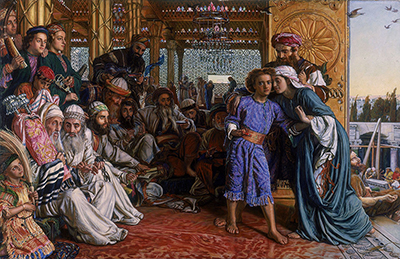The Finding of the Saviour in the Temple is a piece by William Holman Hunt (1854–1860) proposed as an ethnographically exact adaptation of the subject generally known as "Christ Among the Doctors".
It is a delineation of a young Jesus discussing the understanding of the sacred writing with educated rabbis. The section showed from the book of Luke, 2:41, that states the following: Consistently his folks went to Jerusalem for the famous Passover feast. At twelve years of age, they went as indicated by the custom. When the Feast was finished, while his folks were going home, the kid Jesus remained in Jerusalem. However, they were unconscious of it. Thinking he was coming along, they went on for a full day. At that point, they started searching for him among relatives and companions.
Following three days they discovered him in the sanctuary courts, sitting with the educators, talking to them and asking them brilliant inquiries. Everybody who heard him was astonished at his comprehension and his smart answers. At the point when his folks saw him, they were amazed. His mom asked him, "Child, why treat us like this? We have been restlessly looking for you." "For what reason were you looking for me?" he inquired. "Didn't you realise I must be here in my Father's home?" However, they didn't comprehend what he was talking about.
William Hunt portrays the minute at which the parents found Jesus and the rabbis who were in the sanctuary are responding in different approaches to his talk; some are captivated, others are furious or pretentious. Hunt would likewise have known Bernardino Luini's rendition of the same subject found in the well known National Gallery. It was at the time attributed to Leonardo da Vinci. Fixated on renewing religious craftsmanship by underlining ethnographical precision joined with itemised Biblical imagery, Hunt had ventured out to the Middle East to make the image.
He utilised nearby locals as models and contemplating old Judaic traditions and customs. Troubles with models deferred advancement on the sketch, and inevitably Hunt delayed it to take a shot at another task, known as The Scapegoat. He, in the end, finished it in 1860, while in England. His companion Frederic George Stephens composed a flyer containing an itemised clarification of the substance and the involved characters. It has then appeared in a progression of prevalent voyaging presentations at which guests could purchase the handout and buy into an engraved propagation. These were composed by the seller Ernest Gambart and demonstrated an extraordinary achievement.




